英文资料
个人资料英文作文

个人资料英文作文英文:Personal Profile。
Hello, everyone! My name is Lucy and I am from China. I am currently a university student majoring in English. I am a very outgoing and friendly person. I love making new friends and exploring new things. In my free time, I enjoy reading books, watching movies, and listening to music.I am also very interested in learning about different cultures. I have had the opportunity to study abroad in the United States and it was an amazing experience. I learned a lot about American culture and made some great friends along the way.In terms of my future career, I hope to become an English teacher. I have always loved teaching and I believe that being an English teacher will allow me to help othersimprove their language skills while also learning from them.中文:个人资料。
大家好!我叫Lucy,来自中国。
我现在是一名大学英语专业的学生。
英文资料(完整版)

英文资料(完整版)第一部分:引言随着全球化的不断推进,英文作为国际通用语言,其重要性日益凸显。
无论是在学术研究、商业交流还是日常生活中,掌握英语都已成为一种基本能力。
本资料旨在为读者提供一份全面、系统的英文学习指南,涵盖词汇、语法、阅读、写作、听力、口语等多个方面,帮助读者全面提升英语水平。
第二部分:词汇词汇是语言的基础,掌握丰富的词汇量是提高英语水平的关键。
本部分将介绍词汇学习的策略和方法,包括记忆技巧、词汇拓展、同义词辨析等。
同时,还将提供大量的词汇练习,帮助读者巩固所学知识。
第三部分:语法语法是语言的规则,掌握语法是正确表达思想的前提。
本部分将详细介绍英语语法的基本规则,包括时态、语态、句型结构等。
通过大量的语法练习,读者可以更好地理解和运用英语语法。
第四部分:阅读阅读是获取信息、提高语言能力的重要途径。
本部分将介绍阅读技巧和方法,包括快速阅读、精读、理解文章主旨和细节等。
同时,还将提供大量的阅读材料,涵盖不同领域和题材,帮助读者提高阅读能力。
第五部分:写作写作是表达思想、交流观点的重要方式。
本部分将介绍写作技巧和方法,包括文章结构、段落展开、句子构建等。
同时,还将提供大量的写作练习,帮助读者提高写作能力。
第六部分:听力听力是语言输入的重要方式,提高听力能力对于理解英语口语和听力材料至关重要。
本部分将介绍听力技巧和方法,包括预测、笔记、理解主旨和细节等。
同时,还将提供大量的听力材料,帮助读者提高听力能力。
第七部分:口语口语是语言输出的重要方式,提高口语能力对于流利地表达思想至关重要。
本部分将介绍口语技巧和方法,包括发音、语调、词汇运用等。
同时,还将提供大量的口语练习,帮助读者提高口语能力。
本资料涵盖了英语学习的各个方面,旨在为读者提供一份全面、系统的英文学习指南。
通过本资料的学习,读者可以全面提升英语水平,更好地应对各种英语学习和应用场景。
英文资料(完整版)第一部分:引言随着全球化的不断推进,英文作为国际通用语言,其重要性日益凸显。
英文资料
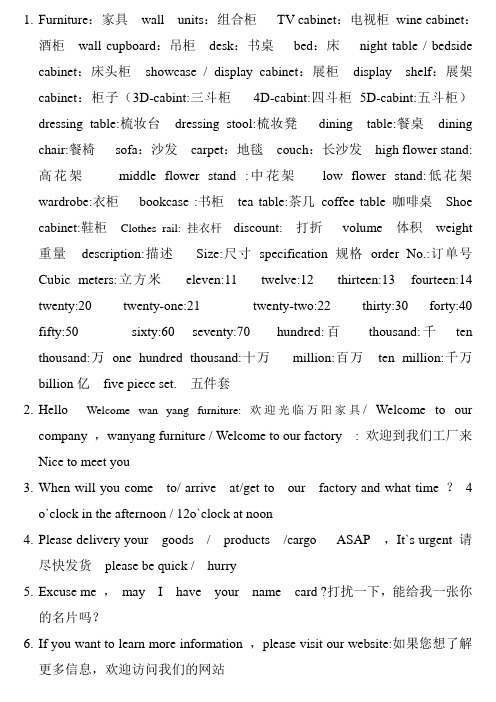
1.Furniture:家具wall units:组合柜TV cabinet:电视柜wine cabinet:酒柜wall cupboard:吊柜desk:书桌bed:床night table / bedside cabinet:床头柜showcase / display cabinet:展柜display shelf:展架cabinet:柜子(3D-cabint:三斗柜4D-cabint:四斗柜5D-cabint:五斗柜)dressing table:梳妆台dressing stool:梳妆凳dining table:餐桌dining chair:餐椅sofa:沙发carpet:地毯couch:长沙发high flower stand:高花架middle flower stand :中花架low flower stand:低花架wardrobe:衣柜bookcase :书柜tea table:茶几coffee table 咖啡桌Shoe cabinet:鞋柜Clothes rail: 挂衣杆discount: 打折volume 体积weight 重量description:描述Size:尺寸specification规格order No.:订单号Cubic meters:立方米eleven:11 twelve:12 thirteen:13 fourteen:14 twenty:20 twenty-one:21 twenty-two:22 thirty:30 forty:40 fifty:50 sixty:60 seventy:70 hundred:百thousand:千ten thousand:万one hundred thousand:十万million:百万ten million:千万billion亿five piece set. 五件套2.Hello Welcome wan yang furniture: 欢迎光临万阳家具/ Welcome to ourcompany ,wanyang furniture / Welcome to our factory : 欢迎到我们工厂来Nice to meet you3.When will you come to/ arrive at/get to our factory and what time ?4o`clock in the afternoon / 12o`clock at noon4.Please delivery your goods / products /cargo ASAP ,It`s urgent 请尽快发货please be quick / hurry5.Excuse me ,may I have your name card ?打扰一下,能给我一张你的名片吗?6.If you want to learn more information ,please visit our website:如果您想了解更多信息,欢迎访问我们的网站7.Let`s go to the showroom:我们去展厅吧This way please Sit down please8.What`s the best / last price ?最低价是多少?This is our lowest price 这是我们的最低价How much do you need? 你需要多少?9.Would you like some drink ?要喝水吗?10.W hat`s the shipping information ?( Name、phone、address)请问货运资料是什么?(姓名、电话、地址)11. We have many other styles , and the prices are nearly close. 我们还有更多的款式,价格都比较接近的。
英文复习资料
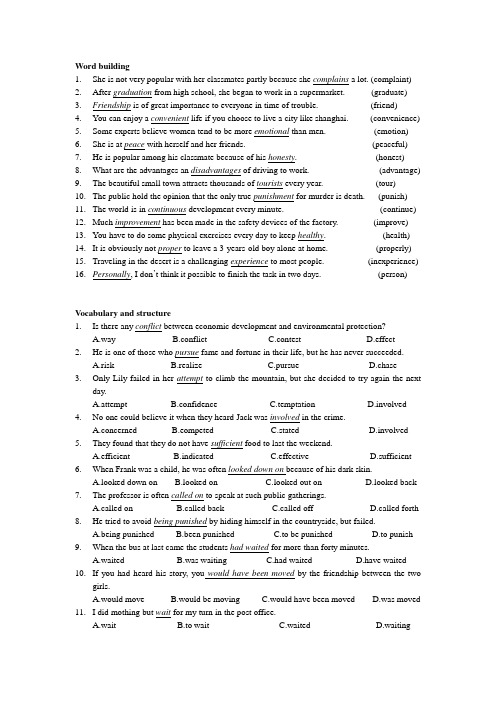
Word building1.She is not very popular with her classmates partly because she complains a lot. (complaint)2.After graduation from high school, she began to work in a supermarket. (graduate)3.Friendship is of great importance to everyone in time of trouble. (friend)4.You can enjoy a convenient life if you choose to live a city like shanghai. (convenience)5.Some experts believe women tend to be more emotional than men. (emotion)6.She is at peace with herself and her friends. (peaceful)7.He is popular among his classmate because of his honesty. (honest)8.What are the advantages an disadvantages of driving to work. (advantage)9.The beautiful small town attracts thousands of tourists every year. (tour)10.The public hold the opinion that the only true punishment for murder is death. (punish)11.The world is in continuous development every minute. (continue)12.Much improvement has been made in the safety devices of the factory. (improve)13.You have to do some physical exercises every day to keep healthy. (health)14.It is obviously not proper to leave a 3-years-old boy alone at home. (properly)15.Traveling in the desert is a challenging experience to most people. (inexperience)16.Personally, I don’t think it possible to finish the task in two days. (person)Vocabulary and structure1.Is there any conflict between economic development and environmental protection?A.wayB.conflictC.contestD.effect2.He is one of those who pursue fame and fortune in their life, but he has never succeeded.A.riskB.realizeC.pursueD.chase3.Only Lily failed in her attempt to climb the mountain, but she decided to try again the nextday.A.attemptB.confidenceC.temptationD.involved4.No one could believe it when they heard Jack was involved in the crime.A.concernedB.eompetedC.statedD.involved5.They found that they do not have sufficient food to last the weekend.A.efficientB.indicatedC.effectiveD.sufficient6.When Frank was a child, he was often looked down on because of his dark skin.A.looked down onB.looked onC.looked out onD.looked back7.The professor is often called on to speak at such public gatherings.A.called onB.called backC.called offD.called forth8.He tried to avoid being punished by hiding himself in the countryside, but failed.A.being punishedB.been punishedC.to be punishedD.to punish9.When the bus at last came the students had waited for more than forty minutes.A.waitedB.was waitingC.had waitedD.have waited10.If you had heard his story, you would have been moved by the friendship between the twogirls.A.would moveB.would be movingC.would have been movedD.was moved11.I did mothing but wait for my turn in the post office.A.waitB.to waitC.waitedD.waiting12.He is a hardworking man. Seldom does he go any where but to his office.A.does he goB.he goesC.he does goD.he did go13.Don’t be so hostile to Tom. Any he is your cousin.A.strictB.hostileC.seriousD.slow14.The doctor is sure that Leo will be able to recover his health, and it is merely a matter of time.A.generallyB.merelypletelyD.deeply15.Eileen intended to go to Paris and spend Christmas together with her boy friend there.A.tendedB.intendedC.attendedD.bothered16.The tourists walked a long distance until they found a shelter from the heavy rain in a hut.A.shadeB.incidentC.stopD.shelter17.I’m sorry to bother you, but can you tell me the way to rail station?A.excuseB.botherC.pardonD.stare18.The question to be discussed tomorrow is how to improve the management.A.discussB.discussedC.discussingD.to be discussed19.It is because he is too young that he does not understand it.A. soB.so thatC.thatD.therefore20.Nowadays most parents consider it important that their children receive a good education.A.whatB.itC.thatD.which21.The table cloth has a pattern of red and white squares.A.patternB.formC.styleD.way22.Are we going to put off the sports meet because of the bad weather?A.get offB.take offC.put offD.keep off23.Some supermarkets have lowered the prices of some of their commodities.A.setB.lowedC.loweredD.lift24.Everyone was shocked at the sight of the man beating his own daughter.A.shockedB.excitedC.connectedD.rewarded25.The two small shops combined to make a large one.A.connectedB.joinedbinedD.united26.The tour guide gathered the visitors in the hotel lobby.A. collectedB.calledC.gatheredD.directed27.Not hearing from my mother, I decided to get in touch with her by telephone.A.Hearing notB.Not hearingC.Not to have heardD.I didn’t hear28.What surprised me was that he couldn’t speak English at all.A.That, thatB.What, whatC.Who, thatD.What, that29.He doesn’t look well, for he has been working for sixteen hours.A.had workedB.was workingC.has been workingD.would have worked30.How I wish that the bus hadn’t broken down on our way back home last night!A.didn’t breakB.would not breakC.hadn’t brokenD.shouldn’t break31.The weather had cleared up so I suggested having a picnic in the country.A.we would have aB.having aC.to have aD.go to32.There are different means of transport in big cities for you to choose when you go out.A.meansB.meanC.meaningsD.meaning33.The bookstore owner replaced the old magazines with a new ones to attract more readers.A.requiredB.reviewedC.repeatedD.replaced34.Would you like to buy the book? It is worth reading.A.worthyB.firmC.furtherD.worth35.She wears sunglasses to protect her eyes from the sunshine in summer.A.prepareB.produceC.protectD.provide36.Jack came to London for the purpose of seeing his girl friend.A.purposeB.supportC.sideD.sense37.I have arranged for my secretary to meet you tomorrow.A.arrangedB.solvedC.offeredD.directed38.Peter has just arrived, and I didn’t know he was coming until last night.A.had comeB.was comingC.will comeD.is to come39.The teacher wants to know whether we have handed in our paper.A.had handed inB.would hand inC.have handed inD.are handing in40.The minute they got there, they began to work.A.gotB.were gettingC.were to getD.would get41.Before I had known him a week he tried to borrow money from me.A.knowB.had knowC.came to knowD.had been knowing42.They don’t know where they should look for the lost child.A.whereB.thatC.whateverD.whoeverTranslation1.那时雨下得很大,但我们还是按时到达了。
英语资料网址大全
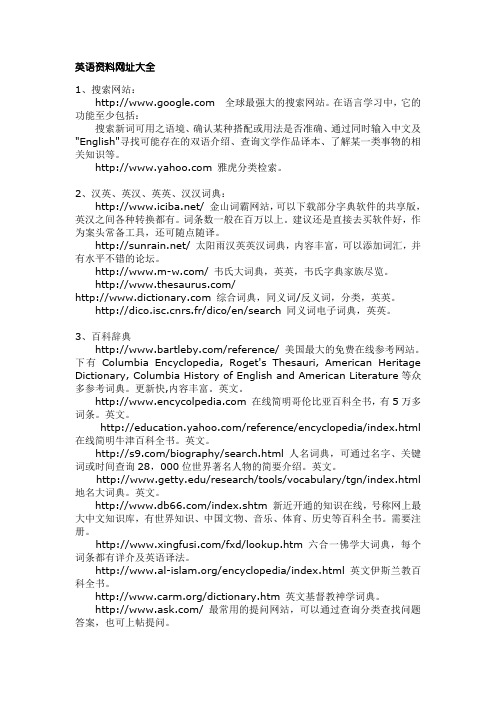
英语资料网址大全1、搜索网站:全球最强大的搜索网站。
在语言学习中,它的功能至少包括:搜索新词可用之语境、确认某种搭配或用法是否准确、通过同时输入中文及"English"寻找可能存在的双语介绍、查询文学作品译本、了解某一类事物的相关知识等。
雅虎分类检索。
2、汉英、英汉、英英、汉汉词典:/ 金山词霸网站,可以下载部分字典软件的共享版,英汉之间各种转换都有。
词条数一般在百万以上。
建议还是直接去买软件好,作为案头常备工具,还可随点随译。
/ 太阳雨汉英英汉词典,内容丰富,可以添加词汇,并有水平不错的论坛。
/ 韦氏大词典,英英,韦氏字典家族尽览。
/ 综合词典,同义词/反义词,分类,英英。
rs.fr/dico/en/search 同义词电子词典,英英。
3、百科辞典/reference/ 美国最大的免费在线参考网站。
下有Columbia Encyclopedia, Roget's Thesauri, American Heritage Dictionary, Columbia History of English and American Literature等众多参考词典。
更新快,内容丰富。
英文。
在线简明哥伦比亚百科全书,有5万多词条。
英文。
/reference/encyclopedia/index.html 在线简明牛津百科全书。
英文。
/biography/search.html 人名词典,可通过名字、关键词或时间查询28,000位世界著名人物的简要介绍。
英文。
/research/tools/vocabulary/tgn/index.html 地名大词典。
英文。
/index.shtm 新近开通的知识在线,号称网上最大中文知识库,有世界知识、中国文物、音乐、体育、历史等百科全书。
需要注册。
/fxd/lookup.htm 六合一佛学大词典,每个词条都有详介及英语译法。
/encyclopedia/index.html 英文伊斯兰教百科全书。
英语学习资料

旅游英语(衣食住行)——出国常用必备英语口语一、紧急情况用语●I’ve lost my passport.我的护照丢拉●Where is Chinese Embassy?中国大使馆在哪?●Could you call for a Chinese speaking staff?能找个中文员工给我吗?二、常用英语口语●Thank you!谢谢!●Thanks a lot!多谢!●Excuse me.对不起,麻烦你。
●Excuse the mess.抱歉●Can I help you?需要帮忙吗?●Thank you for helping me.谢谢你的帮助。
●Thanks,anyway.无论如何,我还要感谢你。
●How are you!您好。
●How do you do!初次见面问好。
●(It's)nice to meet you.很高兴见到你。
●Where are you from?请问您从哪来。
●Can I have your name?请问贵姓。
●It was a pleasure meeting you.很高兴认识你。
●Pleased to meet you.很高兴见到你。
●Hope to see you again.希望再见到你。
●Does that mean that I can see you again?这是不是说我以后可以再见到你?●Have a good time.玩得快乐。
●Good luck.祝你好运。
●I hope nothing is wrong.我希望没事。
●What's the matter?怎么了?●Oh,no!Is it serious?糟糕,严重吗?●I'm sorry for you.我真为你难过。
●Have a safe trip home.一路平安,走好。
三、方向单词●East东●South南●West西●North北●Left左●Right右●Straight on往前直去●There那儿●Front前方●Back后方●Side侧旁●Before之前●After之后●First left/right第一个转左/右的路四、问路常用英语●请问怎么前往飞机场?How do I get to the airport?●我怎样到那里?How can I get there?●请问怎么前往地下铁路站?How do I get to the metro station?●请问怎么前往火车站?How do I get to the train station?●从这儿到那里远吗?How far is it trom here?●请问附近有没有医院?Is there a hospital nearby?●请问附近有没有公共厕所?Is there a public toilet nearby?●这条路通到哪里?Where does this way lead to?●请问附近有没有公共电话?Is there a telephone nearby?●它在哪层楼?What floor is it on?●请问附近有没有银行?Is there a bank nearby?●请问附近有没有假日酒店?Is there a holiday hotel nearby?●我走错方向了吗?Am I in wrong direction?●这是去邮局的路吗?Is this the right way to the post office?●请问怎么前往公车站?How do I get to the bus station?●有公共汽车到那儿吗?Does the bus go there?●请问附近有没有餐厅?Is there a restaurant nearby?●对不起,我刚到这儿。
英语复习资料完整版

英语复习资料完整版导言:英语是一门国际通用语言,具备良好的英语能力对于学习、工作和生活是非常重要的。
无论是参加英语考试还是日常交流,都需要具备扎实的英语基础和充足的复习资料。
本文将提供一份完整版的英语复习资料,以帮助读者进行全面的英语复习。
一、基础知识复习1. 词汇复习:重点复习常用单词和短语,包括动词、名词、形容词、副词等,并掌握它们的用法和搭配。
建议使用词汇书籍或手机应用程序进行词汇记忆。
2. 语法复习:回顾英语的基础语法知识,包括时态、语态、句型转换等。
重点复习一般现在时、一般过去时和一般将来时等常用时态的用法。
3. 句子结构复习:了解英语句子的基本结构和语序规则,掌握主谓宾从等句子结构的用法。
二、听力技巧提升1. 听力材料选择:选择适合自己听力水平的听力材料进行练习。
可以选择录音课程、听力短文、英语新闻等。
通过多次听取和理解,提高自己的听力能力。
2. 笔记记述:在听力练习过程中,可以尝试边听边记笔记。
记录关键词、重点内容和自己的理解,有助于加深记忆和提高理解能力。
3. 对话练习:和他人进行英语对话练习,增强自己的听力和口语能力。
可以选择参加英语角、在线英语聊天室或找外教进行对话练习。
三、口语能力提升1. 模仿发音:通过模仿英语母语者的发音,训练自己的口语能力。
可以选择听力材料进行模仿,也可以参考口语教材中的例句进行跟读。
2. 口语练习:多参与口语练习,提高口语表达能力。
可以找语伴或参加英语角,进行对话练习。
同时,可以尝试进行口头演讲或自由辩论等口语训练。
3. 背诵口语素材:背诵一些常用的口语表达和例句,帮助提高口语流利度和表达能力。
四、阅读理解能力提升1. 阅读材料选择:选择适合自己英语水平和兴趣的阅读材料进行阅读理解练习。
可以选择英语小说、英语杂志、英文报纸等。
2. 阅读技巧:掌握好的阅读技巧,包括快速阅读、精读和扫读等。
通过多次练习,提高自己的阅读速度和理解能力。
3. 生词积累:阅读过程中,遇到不认识的单词和短语,可以进行积累和记忆。
英语资料大全
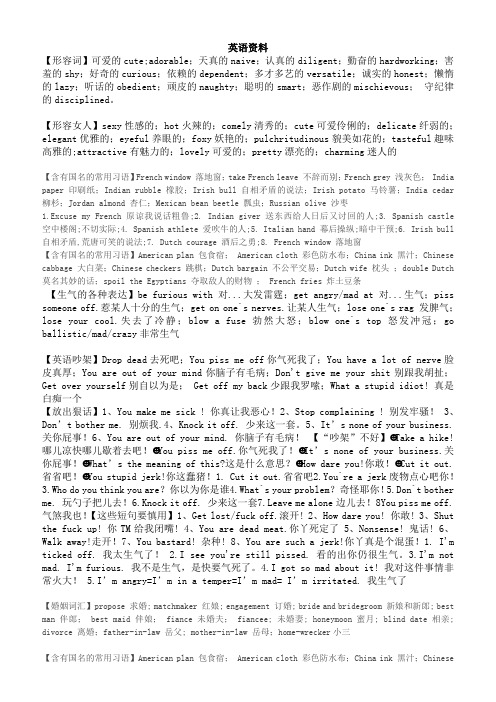
英语资料【形容词】可爱的cute;adorable;天真的naive;认真的diligent;勤奋的hardworking;害羞的shy;好奇的curious;依赖的dependent;多才多艺的versatile;诚实的honest;懒惰的lazy;听话的obedient;顽皮的naughty;聪明的smart;恶作剧的mischievous;守纪律的disciplined。
【形容女人】sexy性感的;hot火辣的;comely清秀的;cute可爱伶俐的;delicate纤弱的;elegant优雅的;eyeful养眼的;foxy妖艳的;pulchritudinous貌美如花的;tasteful趣味高雅的;attractive有魅力的;lovely可爱的;pretty漂亮的;charming迷人的【含有国名的常用习语】French window 落地窗;take French leave 不辞而别;French grey 浅灰色; India paper 印刷纸;Indian rubble 橡胶;Irish bull 自相矛盾的说法;Irish potato 马铃薯;India cedar 柳杉;Jordan almond 杏仁;Mexican bean beetle 瓢虫;Russian olive 沙枣1.Excuse my French 原谅我说话粗鲁;2. Indian giver 送东西给人日后又讨回的人;3. Spanish castle 空中楼阁;不切实际;4. Spanish athlete 爱吹牛的人;5. Italian hand 幕后操纵;暗中干预;6. Irish bull 自相矛盾,荒唐可笑的说法;7. Dutch courage 酒后之勇;8. French window 落地窗【含有国名的常用习语】American plan 包食宿; American cloth 彩色防水布;China ink 黑汁;Chinese cabbage 大白菜;Chinese checkers 跳棋;Dutch bargain 不公平交易;Dutch wife 枕头;double Dutch 莫名其妙的话;spoil the Egyptians 夺取敌人的财物; French fries 炸土豆条【生气的各种表达】be furious with 对...大发雷霆;get angry/mad at对...生气;piss someone off.惹某人十分的生气;get on one`s nerves.让某人生气;lose one`s rag 发脾气;lose your cool.失去了冷静;blow a fuse勃然大怒;blow one`s top怒发冲冠;go ballistic/mad/crazy非常生气【英语吵架】Drop dead去死吧;You piss me off你气死我了;You have a lot of nerve脸皮真厚;You are out of your mind你脑子有毛病;Don't give me your shit别跟我胡扯;Get over yourself别自以为是; Get off my back少跟我罗嗦;What a stupid idiot! 真是白痴一个【放出狠话】1、You make me sick ! 你真让我恶心!2、Stop complaining ! 别发牢骚! 3、Don’t bother me. 别烦我.4、Knock it off. 少来这一套。
资料的英语单词

Document:文档,文件,通常指书面的信息或资料。
Material:材料,物资,通常指用于特定目的或用途的物品。
Data:数据,资料,通常指以数字或符号形式记录的信息。
Information:信息,情报,通常指用于理解或解决问题的知识或数据。
Reference Material:参考材料,通常指用于提供额外信息或解释的来源。
Resource Material:资源材料,通常指用于特定项目或领域的书籍、文章或其他来源的信息。
Bibliography:参考书目,通常指学术论文或书籍的书目列表。
Manuscript:手稿,通常指未编辑或未出版的文本。
Archive:档案馆,通常指存储大量历史或官方文件的场所。
Library:图书馆,通常指存储大量书籍、期刊和其他资料的场所。
英语入门学习资料
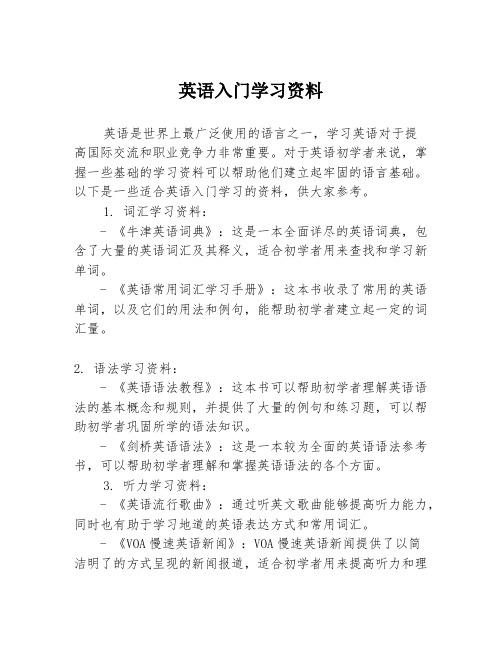
英语入门学习资料英语是世界上最广泛使用的语言之一,学习英语对于提高国际交流和职业竞争力非常重要。
对于英语初学者来说,掌握一些基础的学习资料可以帮助他们建立起牢固的语言基础。
以下是一些适合英语入门学习的资料,供大家参考。
1. 词汇学习资料:- 《牛津英语词典》:这是一本全面详尽的英语词典,包含了大量的英语词汇及其释义,适合初学者用来查找和学习新单词。
- 《英语常用词汇学习手册》:这本书收录了常用的英语单词,以及它们的用法和例句,能帮助初学者建立起一定的词汇量。
2. 语法学习资料:- 《英语语法教程》:这本书可以帮助初学者理解英语语法的基本概念和规则,并提供了大量的例句和练习题,可以帮助初学者巩固所学的语法知识。
- 《剑桥英语语法》:这是一本较为全面的英语语法参考书,可以帮助初学者理解和掌握英语语法的各个方面。
3. 听力学习资料:- 《英语流行歌曲》:通过听英文歌曲能够提高听力能力,同时也有助于学习地道的英语表达方式和常用词汇。
- 《VOA慢速英语新闻》:VOA慢速英语新闻提供了以简洁明了的方式呈现的新闻报道,适合初学者用来提高听力和理解能力。
4. 阅读学习资料:- 《英语阅读教程》:这本书收录了一些简短的英语文章,适合初学者用来提高阅读能力和理解能力。
- 《英语经典小说》:选择一些适合自己水平的经典英语小说进行阅读,可以提高阅读技巧和丰富词汇量。
5. 口语学习资料:- 《英语口语学习指南》:这本书提供了一些常用的口语表达方式和例句,适合初学者用来提高口语能力。
- 与英语为母语的人交流:与英语为母语的人进行交流是提高口语能力的最好方式,可以通过一些英语角、语言交流网站等途径找到合适的交流伙伴。
这些学习资料可以帮助初学者全面提高英语水平,但最重要的还是坚持学习和练习。
通过不断地积累词汇、理解语法、提高听说读写的能力,初学者将能够逐渐感受到英语的魅力和实用性。
英文资料(完整版)

英文资料(完整版)文档内容:本资料旨在为读者提供一份全面、详尽的英文学习资源,涵盖词汇、语法、句型、阅读、写作等多个方面。
无论你是初学者还是进阶者,这份资料都能帮助你更好地掌握英语,提升语言能力。
一、词汇部分1. 基础词汇:包括日常生活、工作、学习等各个领域的常用词汇,如时间、天气、食物、家庭、职业等。
2. 高级词汇:包括一些较为专业、生僻的词汇,如科技、金融、法律、医学等领域的专业术语。
3. 词根词缀:介绍一些常见的词根词缀,帮助读者通过记忆词根词缀来扩大词汇量。
4. 词汇搭配:介绍一些常见的词汇搭配,帮助读者更好地理解和使用词汇。
二、语法部分1. 基础语法:包括时态、语态、句型结构等基础语法知识。
2. 高级语法:包括虚拟语气、倒装句、省略句等高级语法知识。
3. 语法练习:提供一些语法练习题,帮助读者巩固所学知识。
三、句型部分1. 常用句型:介绍一些日常生活中常用的句型,如问候、介绍、道歉、感谢等。
2. 功能句型:介绍一些特定场景下使用的句型,如购物、旅游、面试等。
3. 句型练习:提供一些句型练习题,帮助读者掌握句型用法。
四、阅读部分1. 阅读技巧:介绍一些提高阅读速度和理解能力的技巧。
2. 阅读材料:提供一些不同难度、不同类型的阅读材料,如新闻、故事、文章等。
3. 阅读练习:提供一些阅读练习题,帮助读者提高阅读能力。
五、写作部分1. 写作技巧:介绍一些提高写作能力的方法和技巧。
2. 写作范文:提供一些不同类型、不同风格的写作范文,如记叙文、议论文、说明文等。
3. 写作练习:提供一些写作练习题,帮助读者提高写作能力。
六、听力部分1. 听力技巧:介绍一些提高听力理解能力的方法和技巧。
2. 听力材料:提供一些不同难度、不同类型的听力材料,如对话、演讲、新闻等。
3. 听力练习:提供一些听力练习题,帮助读者提高听力能力。
七、口语部分1. 口语技巧:介绍一些提高口语表达能力的方法和技巧。
2. 口语话题:提供一些不同类型的口语话题,如日常生活、工作、学习等。
个人资料英文作文
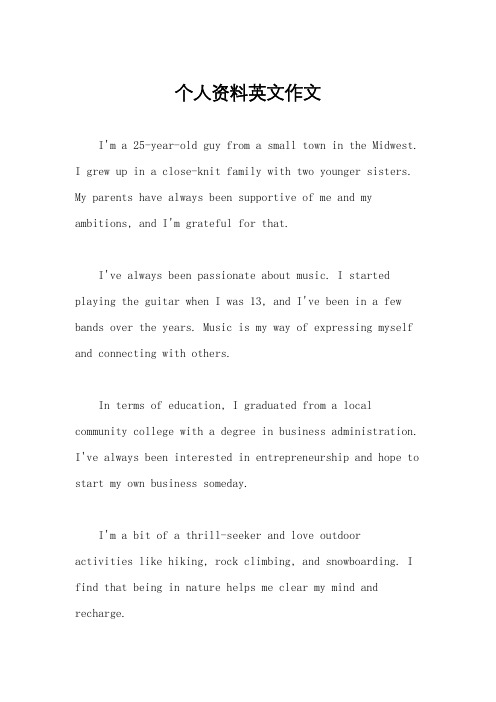
个人资料英文作文I'm a 25-year-old guy from a small town in the Midwest.I grew up in a close-knit family with two younger sisters. My parents have always been supportive of me and my ambitions, and I'm grateful for that.I've always been passionate about music. I started playing the guitar when I was 13, and I've been in a few bands over the years. Music is my way of expressing myself and connecting with others.In terms of education, I graduated from a local community college with a degree in business administration. I've always been interested in entrepreneurship and hope to start my own business someday.I'm a bit of a thrill-seeker and love outdooractivities like hiking, rock climbing, and snowboarding. I find that being in nature helps me clear my mind and recharge.I'm a big foodie and love trying new restaurants and cuisines. Cooking is also a hobby of mine, and I enjoy experimenting with different recipes in the kitchen.I'm a firm believer in giving back to the community, so I volunteer at a local homeless shelter on weekends. It's important to me to make a positive impact on the world around me.Overall, I'm just a regular guy trying to make the most out of life and enjoy the journey.。
英语提升资料
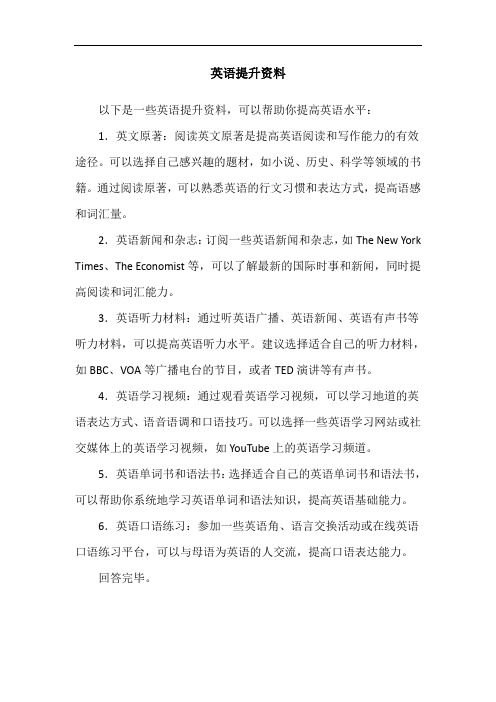
英语提升资料
以下是一些英语提升资料,可以帮助你提高英语水平:
1.英文原著:阅读英文原著是提高英语阅读和写作能力的有效途径。
可以选择自己感兴趣的题材,如小说、历史、科学等领域的书籍。
通过阅读原著,可以熟悉英语的行文习惯和表达方式,提高语感和词汇量。
2.英语新闻和杂志:订阅一些英语新闻和杂志,如The New York Times、The Economist等,可以了解最新的国际时事和新闻,同时提高阅读和词汇能力。
3.英语听力材料:通过听英语广播、英语新闻、英语有声书等听力材料,可以提高英语听力水平。
建议选择适合自己的听力材料,如BBC、VOA等广播电台的节目,或者TED演讲等有声书。
4.英语学习视频:通过观看英语学习视频,可以学习地道的英语表达方式、语音语调和口语技巧。
可以选择一些英语学习网站或社交媒体上的英语学习视频,如YouTube上的英语学习频道。
5.英语单词书和语法书:选择适合自己的英语单词书和语法书,可以帮助你系统地学习英语单词和语法知识,提高英语基础能力。
6.英语口语练习:参加一些英语角、语言交换活动或在线英语口语练习平台,可以与母语为英语的人交流,提高口语表达能力。
回答完毕。
资料用英文怎么说

资料用英文怎么说资料用英文怎么说英语是一种西日耳曼语支,最早被中世纪的英国使用,并因其广阔的殖民地而成为世界使用面积最广的语言。
以下是店铺为大家整理的资料用英文怎么说,仅供参考,大家一起来看看吧。
资料的英文:datamaterial参考例句:Extraneous material in a book书中的题外资料.Examination provides corroborative data检查则提供确证的资料。
Company brochures/promotional materials公司手册/宣传资料The author has examined all the relevant source material.作者研究了全部有关的原始资料。
People had no previous information to guide them.人们尚无前人的资料可供借鉴。
The Classics Pavilion houses a rich collection of historical records.藏经阁内存有丰富的历史资料。
Please attach photocopy of Business Registration Certificate a copy of company brochure.请附上商业登记证副本及公司资料。
Predict(results)based on known data;extrapolate(根据现有资料)预测(结果);推断The spectroscopic data muddy the picture further分光观测资料进一步扰乱了这一图景。
The computer malfunctioned and printed out the wrong data 计算机出了故障, 印出的资料不正确.data是什么意思:n. 数据;资料;[datum] 的复数形式grouping of data资料归类We keep the data in a computer data bank.我们把资料保存在电脑数据库里。
英文个人资料填写

个人资料name 姓名alias 别名pen name 笔名date of birth 出生日期birth date 出生日期born 出生于birth place 出生地点age 年龄native place 籍贯province 省city 市autonomous region 自治区prefecture 专区county 县nationality 民族,国籍citizenship 国籍duel citizenship 双重国籍address 地址current address 目前地址present address 目前地址permanent address 永久地址postal code 邮政编码home phone 住宅电话office phone 办公电话business phone 办公电话Tel.电话sex 性别male 男female 女height 身高weight 体重marital status 婚姻状况family status 家庭状况married 已婚single/unmarried 未婚divorced 离异separated 分居number of children 子女人数none 无street 街lane 胡同,巷road 路district 区house number 门牌health 健康状况health condition 健康状况blood type 血型short-sighted 近视far-sighted 远视color-blind 色盲ID card No.身份证号码date of availability 可到职时间available 可到职membership 会员,资格president 会长vice-president 副会长director 理事standing director 常务理事secretary general 秘书长society 学会association 协会research society 研究会教育程度education 学历educational background 教育程度educational history 学历curriculum 课程major 主修minor 副修educational highlights 课程重点部分curriculum included 课程包括specialized courses 专门课程courses taken 所学课程courses completed 所学课程special training 特别训练social practice 社会实践part-time jobs 业余工作summer jobs 暑期工作vacation jobs 假期工作refresher course 进修课程extracurricular activities 课外活动physical activities 体育活动recreational activities 娱乐活动academic activities 学术活动social activities 社会活动rewards 奖励scholarship 奖学金"Three Goods" student 三好学生excellent League member 优秀团员excellent leader 优秀干部student council 学生会off-job training 脱产培训in-job training 在职培训educational system 学制academic year 学年semester 学期(美)term 学期(英)president 校长vice-president 副校长dean 院长assistant dean 副院长academic dean 教务长department chairman 系主任professor 教授associate professor 副教授guest professor 客座教授lecturer 讲师teaching assistant助教research fellow 研究员research assistant 助理研究员supervisor 论文导师principal 中学校长(美)headmaster 中学校长(英)master 小学校长(美)dean of studies 教务长dean of students 教导主任dean of students 教导主任teacher 教师probation teacher 代课教师tutor 家庭教师governess 女家庭教师intelligence quotient 智商pass 及格fail 不及格marks 分数grades 分数scores 分数examination 考试grade 年级class 班级monitor 班长vice-monitor副班长commissary in charge of studies 学习委员commissary in charge of entertainment 文娱委员commissary in charge of sports 体育委员commissary in charge of physical labor 劳动委员Party branch secretary 党支部书记League branch secretary 团支部书记commissary in charge of organization 组织委员commissary in charge of publicity 宣传委员degree 学位post doctorate 博士后doctor (Ph.D) 博士master 硕士bachelor 学士student 学生graduate student研究生abroad student 留学生returned student 回国留学生foreign student 外国学生undergraduate 大学肄业生senior 大学四年级学生;高中三年级学生Junior 大学三年级学生;高中二年级学生sophomore 大学二年级学生;高中一年级学生freshman 大学一年级学生guest student 旁听生(英)auditor 旁听生(美)government-supported student 公费生commoner 自费生extern 走读生day-student 走读生intern 实习生prize fellow 奖学金生boarder 寄宿生classmate 同班同学schoolmate 同校同学graduate 毕业生工作经历accomplish 完成(任务等)achievements 工作成就,业绩adapted to 适应于adept in 善于administer 管理advanced worker 先进工作者analyze 分析appointed 被任命的assist 辅助authorized 委任的;核准的be promoted to 被提升为be proposed as 被提名为;被推荐为behave 表现breakthrough 惊人的进展,关键问题的解决break the record 打破记录business background 工作经历business experience 工作经历business history 工作经历conduct 经营,处理control 控制cost 成本;费用create 创造decrease 减少demonstrate 证明,示范design 设计develop 开发,发挥devise 设计,发明direct 指导double 加倍,翻一番duties职责earn 获得,赚取effect 效果,作用eliminate 消除employment experience工作经历employment record 工作经历employment 工作enlarge 扩大enliven 搞活enrich 使丰富establish 设立(公司等);使开业;确立evaluation 估价,评价excellent League member 优秀团员excellent Party member 优秀党员execute 实行,实施expand 推广;扩大expedite 加快;促进experience 经历exploit开发(资源,产品)export 出口found 创立generate 产生good at 擅长于guide 指导;操纵implement 完成,实施import 进口improve 改进,提高increase 增加influence 影响initiate 创始,开创innovate 改革,革新inspired 受启发的;受鼓舞的install 安装integrate 使结合;使一体化introduce 采用,引进invent 发明invest 投资job title 职位justified 经证明的;合法化的launch 开办(新企业)lead 领导lengthen 延长lessen 减少(生产成本)level 水平localize 使地方化maintain 保持;维修make 制造manage 管理,经营manufacture 制造mastered 精通的modernize 使现代化motivate 促进,激发negotiate 谈判nominated 被提名的;被任命的occupational history 工作经历operate 操作,开动(机器等),经营(厂矿)organize 组织originate 创始,发明overcome 克服(困难等)participate in 参加perfect 使完善;改善perform 执行,履行plan 计划position 职位professional history 职业经历professional 职业经历profit 利润promote 生产,制造promote 推销(商品);创立(企业)等provide 提供,供应raise 提高reach 达到realize 实现(目标等);获得(利润)receive 收到,得到,接受recognize 认清(职责等)recommended 被推荐的;被介绍的reconsolidate 重新巩固;重新整顿reconstruct 重建recorded 记载的recover恢复;弥补rectify 整顿,调整redouble 加倍,倍增reduce 减少,降低(成本等)refine 精练,精制reform 改革regenerate 更新,使更生registered 已注册的regularize 使系统化regulate 控制(费用等)rehandle 重铸;重新处理rehash以新形式处理(旧材料)reinforce 加强reckon计算(成本等)renew 重建,换新renovate 革新;修理repair 修复,修补replace 接替,替换representative 代表,代理人research 调查,研究resolve 解决responsibilities 职责second job 第二职业set 创造(纪录等)settle 解决(问题等)shorten 减低......效能show 显示,表明significant 重要的,有效的simplify 简化,精简solve 解决sort out 清理specific experience 具体经历speed up 加速sponsor 主办spread 传播,扩大standard 标准,规格streamline 把......设计流线型strengthen 加强,巩固study研究succeed 成功supervise 监督,管理supply 供给,满足(需要) systematize 使系统化target 目标,指标test 试验,检验top 头等的,最高的total 总数,总额translate 翻译,转化travel 旅行unify 使成一体,统一use 使用,运用useful 有用的utilize 利用valuable 有价值的vivify 使活跃well-trained 训练有素的work experience 工作经历work history 工作经历work 工作,起作用working model 劳动模范worth 使......钱的,有......价值的个人品质able 有才干的,能干的active 主动的,活跃的adaptable 适应性强的adroit 灵巧的,机敏的aggressive 有进取心的alert 机灵的ambitious 有雄心壮志的amiable 和蔼可亲的amicable 友好的analytical 善于分析的apprehensive 有理解力的aspiring 有志气的,有抱负的audacious 大胆的,有冒险精神的capable 有能力的,有才能的careful 办事仔细的candid 正直的charitable 宽厚的competent 能胜任的confident 有信心的conscientious 认真的,自觉的considerate 体贴的constructive 建设性的contemplative 好沉思的cooperative 有合作精神的creative 富创造力的dashing 有一股子冲劲的,有拼搏精神的dedicated 有奉献精神的devoted 有献身精神的dependable 可靠的diplomatic 老练的,有策略的disciplined 守纪律的discreet (在行动,说话等方面)谨慎的dutiful 尽职的dynamic 精悍的earnest 认真的well-educated 受过良好教育的efficient 有效率的energetic 精力充沛的enthusiastic 充满热情的expressive 善于表达faithful守信的,忠诚的forceful (性格)坚强的frank 直率的,真诚的friendly 友好的frugal 俭朴的generous 宽宏大量的genteel 有教养的gentle 有礼貌的hard-working 勤劳的hearty 精神饱满的honest 诚实的hospitable 殷勤的humble恭顺的humorous 幽默的impartial 公正的independent 有主见的industrious 勤奋的ingenious 有独创性的initiative 首创精神have an inquiring mind 爱动脑筋intellective 有智力的intelligent 理解力强的inventive 有发明才能的,有创造力的just 正直的kind-hearted 好心的knowledgeable 有见识的learned 精通某门学问的liberal 心胸宽大的logical 条理分明的loyal 忠心耿耿的methodical 有方法的modest 谦虚的motivated 目的明确的objective 客观的open-minded 虚心的orderly 守纪律的original 有独创性的painstaking 辛勤的,苦干的,刻苦的practical 实际的precise 一丝不苟的persevering 不屈不挠的punctual 严守时刻的purposeful 意志坚强的qualified 合格的rational 有理性的realistic 实事求是的reasonable 讲道理的reliable 可信赖的responsible 负责的self-conscious 自觉的selfless 无私的sensible 明白事理的sincere 真诚的smart 精明的spirited 生气勃勃的sporting 光明正大的steady 塌实的straightforward 老实的strict 严格的systematic 有系统的strong-willed 意志坚强的sweet-tempered 性情温和的temperate 稳健的tireless 孜孜不倦的其它内容objective 目标career objective 职业目标employment objective 工作目标position wanted 希望职位job objective 工作目标position applied for 申请职位position sought 谋求职位position desired 希望职位for more specialized work 为更专门的工作for prospects of promotion 为晋升的前途for higher responsibility 为更高层次的工作责任for wider experience 为扩大工作经验due to close-down of company 由于公司倒闭due to expiry of employment 由于雇用期满offered a more challenging opportunity 获得的更有挑战性的工作机会sought a better job 找到了更好的工作to look for a more challenging opportunity 找一个更有挑战性的工作机会to seek a better job 找一份更好的工作。
英文简历个人资料写法
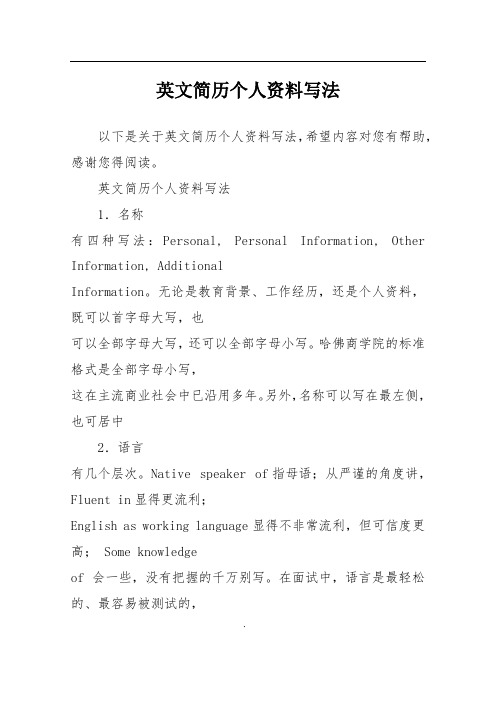
英文简历个人资料写法以下是关于英文简历个人资料写法,希望内容对您有帮助,感谢您得阅读。
英文简历个人资料写法1.名称有四种写法:Personal, Personal Information, Other Information, AdditionalInformation。
无论是教育背景、工作经历,还是个人资料,既可以首字母大写,也可以全部字母大写,还可以全部字母小写。
哈佛商学院的标准格式是全部字母小写,这在主流商业社会中已沿用多年。
另外,名称可以写在最左侧,也可居中2.语言有几个层次。
Native speaker of指母语;从严谨的角度讲,Fluent in显得更流利;English as working language显得不非常流利,但可信度更高; Some knowledgeof 会一些,没有把握的千万别写。
在面试中,语言是最轻松的、最容易被测试的,·一旦被考倒,他会认为你在撒谎,甚至认为通篇都有很多撒谎的地方。
外企公司不会雇用撒谎或有撒谎嫌疑的人。
3.电脑中国人最爱用"熟悉"(familiar)。
无论中文还是英文简历,"熟悉"是一个很弱的字眼,说明你不熟练,不常用。
如果几个软件,有的熟练,有的熟悉,建议只写软件名。
完全没把握的,一点儿不熟悉的,千万不要写。
不要以为没有电脑,就不会考你,他也会考你一两个关键用法。
如果真的用的很多,不妨用"Frequent user of"。
4.资格证书最需要注意的是,有些人将注册会计师笼统地翻译成CPA,但全世界各国都有自己的CPA,有些是互不承认的,所以一定要写上国别,写明考取年份。
有一些业余爱好,能显示出一定素养的内容,也可以写上,如钢琴考级。
TOEFL、GRE和GMAT,应不应该写?应该写哪一个?我们建议都不写。
因为一般外企公·司不愿意雇用很快就要出国的人。
5.爱好与特长1)写强项。
- 1、下载文档前请自行甄别文档内容的完整性,平台不提供额外的编辑、内容补充、找答案等附加服务。
- 2、"仅部分预览"的文档,不可在线预览部分如存在完整性等问题,可反馈申请退款(可完整预览的文档不适用该条件!)。
- 3、如文档侵犯您的权益,请联系客服反馈,我们会尽快为您处理(人工客服工作时间:9:00-18:30)。
Light and ColorLight is a complex phenomenon that is classically explained with a simple model based on rays and wavefronts. The Molecular Expressions Microscopy Primer explores many of the aspects of visible light starting with an introduction to electromagnetic radiation and continuing through to human vision and the perception of color. Each section outlined below is an independent treatise on a limited aspect of light and color. We hope you enjoy your visit and find the answers to your questions.Electromagnetic Radiation - Visible light is a complex phenomenon that is classically explained with a simple model based on propagating rays and wavefronts, a concept first proposed in the late 1600s by Dutch physicist Christiaan Huygens. Electromagnetic radiation, the larger family of wave-like phenomena to which visible light belongs (also known as radiant energy), is the primary vehicle transporting energy through the vast reaches of the universe. The mechanisms by which visible light is emitted or absorbed by substances, and how it predictably reacts under varying conditions as it travels through space and the atmosphere, form the basis of the existence of color in our universe.Light: Particle or a Wave? - Many distinguished scientists have attempted to explain how electromagnetic radiation can display what has now been termed duality, or both particle-like and wave-like behavior. At times light behaves as if composed of particles, and at other times as a continuous wave. This complementary, or dual, role for the properties of light can be employed to describe all of the known characteristics that have been observed experimentally, ranging from refraction, reflection, interference, and diffraction, to the results with polarized light and the photoelectric effect.Sources of Visible Light - A wide variety of sources are responsible for emission of electromagnetic radiation, and are generally categorized according to the specific spectrum of wavelengths generated by the source. Relatively long radio waves are produced by electrical current flowing through huge broadcast antennas, while much shorter visible light waves are produced by the energy state fluctuations of negatively charged electrons within atoms. The shortest form of electromagnetic radiation, gamma waves, results from decay of nuclear components at the center of the atom. The visible light that humans are able to see is usually a mixture of wavelengths whose varying composition is a function of the light source.Fluorescence - The phenomenon of fluorescence was known by the middle of the nineteenth century. British scientist Sir George G. Stokes first made the observation that the mineral fluorspar exhibits fluorescence when illuminated with ultraviolet light, and he coined the word "fluorescence". Stokes observed that the fluorescing light has longer wavelengths than the excitation light, a phenomenon that has become to be known as the Stokes shift. Fluorescence microscopy is an excellent method of studying material that can be made to fluoresce, either in its natural form (termed primary or auto fluorescence) or when treated with chemicals capable of fluorescing (known as secondary fluorescence). The fluorescence microscope was devised in the early part of the twentiethcentury by August K鰄ler, Carl Reichert, and Heinrich Lehmann, among others. However, the potential of this instrument was not realized for several decades, and fluorescence microscopy is now an important (and perhaps indispensable) tool in cellular biology.Speed of Light - Starting with Ole Roemer's 1676 breakthrough endeavors, the speed of light has been measured at least 163 times by more than 100 investigators utilizing a wide variety of different techniques. Finally in 1983, more than 300 years after the first serious measurement attempt, the speed of light was defined as being 299,792.458 kilometers per second by the Seventeenth General Congress on Weights and Measures. Thus, the meter is defined as the distance light travels through a vacuum during a time interval of1/299,792,458 seconds. In general, however, (even in many scientific calculations) the speed of light is rounded to 300,000 kilometers (or 186,000 miles) per second.Reflection of Light - Reflection of light (and other forms of electromagnetic radiation) occurs when the waves encounter a surface or other boundary that does not absorb the energy of the radiation and bounces the waves away from the surface. The incoming light wave is referred to as an incident wave and the wave that is bounced away from the surface is called the reflected wave. The simplest example of visible light reflection is the glass-like surface of a smooth pool of water, where the light is reflected in an orderly manner to produce a clear image of the scenery surrounding the pool. Throw a rock into the pool, and the water is perturbed to form waves, which disrupt the image of the scene by scattering the reflected light in all directions.Refraction of Light - As light passes from one substance into another, it will travel straight through with no change of direction when crossing the boundary between the two substances head-on (perpendicular, or a 90-degree angle of incidence). However, if the light impacts the boundary at any other angle it will be bent or refracted, with the degree of refraction increasing as the beam is progressively inclined at a greater angle with respect to the boundary. As an example, a beam of light striking water vertically will not be refracted, but if the beam enters the water at a slight angle it will be refracted to a very small degree. If the angle of the beam is increased even further, the light will refract with increasing proportion to the entry angle. Early scientists realized that the ratio between the angle at which the light crosses the media interface and the angle produced after refraction is a very precise characteristic of the material producing the refraction effect.Diffraction of Light - Depending on the circumstances that give rise to the phenomenon, diffraction can be perceived in a variety of different ways. Scientists have cleverly utilized diffraction of neutrons and X-rays to elucidate the arrangement of atoms in small ionic crystals, molecules, and even such large macromolecular assemblies as proteins and nucleic acids. Electron diffraction is often employed to examine periodic features of viruses, membranes, and other biological organisms, as well as synthetic and naturally occurring materials. No lens exists that will focus neutrons and X-rays into an image, so investigators must reconstruct images of molecules and proteins from the diffraction patterns using sophisticated mathematical analysis. Fortunately, magnetic lenses canfocus diffracted electrons in the electron microscope, and glass lenses are very useful for focusing diffracted light to form an optical image that can easily be viewed.Polarization of Light - The human eye lacks the ability to distinguish between randomly oriented and polarized light, and plane-polarized light can only be detected through an intensity or color effect, for example, by reduced glare when wearing polarized sun glasses. In effect, humans cannot differentiate between the high contrast real images observed in a polarized light microscope and identical images of the same specimens captured digitally (or on film), and then projected onto a screen with light that is not polarized. The first clues to the existence of polarized light surfaced around 1669 when Erasmus Bartholin discovered that crystals of the mineral Iceland spar (more commonly referred to as calcite) produce a double image when objects are viewed through the crystals in transmitted light. During his experiments, Bartholin also observed a quite unusual phenomenon. When the calcite crystals are rotated about their axis, one of the images moves in a circle around the other, providing strong evidence that the crystals are somehow splitting the light into two different beams.Fundamentals of Interference - The seemingly close relationship between diffraction and interference occurs because they are actually manifestations of the same physical process and produce ostensibly reciprocal effects. Most of us observe some type of optical interference almost every day, but usually do not realize the events in play behind the often-kaleidoscopic display of color produced when light waves interfere with each other. One of the best examples of interference is demonstrated by the light reflected from a film of oil floating on water. Another example is the thin film of a soap bubble, which reflects a spectrum of beautiful colors when illuminated by natural or artificial light sources.Optical Birefringence - Anisotropic crystals, such as quartz, calcite, and tourmaline, have crystallographically distinct axes and interact with light by a mechanism that is dependent upon the orientation of the crystalline lattice with respect to the incident light angle. When light enters the optical axis of anisotropic crystals, it behaves in a manner similar to the interaction with isotropic crystals, and passes through at a single velocity. However, when light enters a non-equivalent axis, it is refracted into two rays each polarized with the vibration directions oriented at right angles to one another, and traveling at different velocities. This phenomenon is termed double refraction or birefringence and is exhibited to a greater or lesser degree in all anisotropic crystals.Color Temperature - The concept of color temperature is of critical importance in photography and digital imaging, regardless of whether the image capture device is a camera, microscope, or telescope. A lack of proper color temperature balance between the microscope light source and the film emulsion or image sensor is the most common reason for unexpected color shifts in photomicrography and digital imaging. If the color temperature of the light source is too low for the film, photomicrographs will have an overall yellowish or reddish cast and will appear warm. On the other hand, when the color temperature of the light source is too high for the film, photomicrographs will have a bluecast and will appear cool. The degree of mismatch will determine the extent of these color shifts, with large discrepancies leading to extremes in color variations. Perhaps the best example is daylight film used in a microscope equipped with a tungsten-halogen illumination source without the benefit of color balancing filters. In this case, the photomicrographs will have a quite large color shift towards warmer reddish and yellowish hues. As problematic as these color shifts may seem, they are always easily corrected by the proper use of conversion and light balancing filters.Primary Colors - The human eye is sensitive to a narrow band of electromagnetic radiation that lies in the wavelength range between 400 and 700 nanometers, commonly known as the visible light spectrum, which is the only source of color. When combined, all of the wavelengths present in visible light, about a third of the total spectral distribution that successfully passes through the Earth's atmosphere, form colorless white light that can be refracted and dispersed into its component colors by means of a prism. The colors red, green, and blue are classically considered the primary colors because they are fundamental to human vision. Light is perceived as white by humans when all three cone cell types are simultaneously stimulated by equal amounts of red, green, and blue light.Light Filters - A majority of the common natural and artificial light sources emit a broad range of wavelengths that cover the entire visible light spectrum, with some extending into the ultraviolet and infrared regions as well. For simple lighting applications, such as interior room lights, flashlights, spot and automobile headlights, and a host of other consumer, business, and technical applications, the wide wavelength spectrum is acceptable and quite useful. However, in many cases it is desirable to narrow the wavelength range of light for specific applications that require a selected region of color or frequency. This task can be easily accomplished through the use of specialized filters that transmit some wavelengths and selectively absorb, reflect, refract, or diffract unwanted wavelengths.Human Vision and Color Perception - Human stereo color vision is a very complex process that is not completely understood, despite hundreds of years of intense study and modeling. Vision involves the nearly simultaneous interaction of the two eyes and the brain through a network of neurons, receptors, and other specialized cells. The first steps in this sensory process are the stimulation of light receptors in the eyes, conversion of the light stimuli or images into signals, and transmission of electrical signals containing the vision information from each eye to the brain through the optic nerves. This information is processed in several stages, ultimately reaching the visual cortices of the cerebrum.Light and Energy - Mankind has always been dependent upon energy from the sun's light both directly - for warmth, to dry clothing, to cook, and indirectly to provide food, water, and air. Our awareness of the value of the sun's rays revolves around the manner in which we benefit from the energy, but there are far more fundamental implications from the relationship between light and energy. Whether or not mankind devises ingenius mechanisms to harness the sun's energy, our planet and the changing environment contained within is naturally driven by the energy of sunlight.Introduction to Lenses and Geometrical Optics - The action of a simple lens, similar to many of those used in the microscope, is governed by the principles of refraction and reflection and can be understood with the aid of a few simple rules about the geometry involved in tracing light rays through the lens. The basic concepts explored in this discussion, which are derived from the science of Geometrical Optics, will lead to an understanding of the magnification process, the properties of real and virtual images, and lens aberrations or defects.Basic Properties of Mirrors - Reflection of light is an inherent and important fundamental property of mirrors, and is quantitatively gauged by the ratio between the amount of light reflected from the surface and that incident upon the surface, a term known as reflectivity. Mirrors of different design and construction vary widely in their reflectivity, from nearly 100 percent for highly-polished mirrors coated with metals that reflect visible and infrared wavelengths, to nearly zero for strongly absorbing materials.Prisms and Beamsplitters - Prisms and beamsplitters are essential components that bend, split, reflect, and fold light through the pathways of both simple and sophisticated optical systems. Cut and ground to specific tolerances and exact angles, prisms are polished blocks of glass or other transparent materials that can be employed to deflect or deviate a light beam, rotate or invert an image, separate polarization states, or disperse light into its component wavelengths. Many prism designs can perform more than one function, which often includes changing the line of sight and simultaneously shortening the optical path, thus reducing the size of optical instruments.Laser Fundamentals - Ordinary natural and artificial light is released by energy changes on the atomic and molecular level that occur without any outside intervention. A second type of light exists, however, and occurs when an atom or molecule retains its excess energy until stimulated to emit the energy in the form of light. Lasers are designed to produce and amplify this stimulated form of light into intense and focused beams. The word laser was coined as an acronym for L ight A mplification by the S timulated E mission of R adiation. The special nature of laser light has made laser technology a vital tool in nearly every aspect of everyday life including communications, entertainment, manufacturing, and medicine.Light and Color Java Tutorials - Difficult concepts in the physics of light and the science of optics are much easier to understand with the aid of interactive tutorials that demonstrate various aspects of the principles involved. Check out these cool Java tutorial-applets that explore a wide range of concepts in light, color, and optics.Introduction to Optical Microscopy,Digital Imaging, and PhotomicrographyThis treatise on optical microscopy is divided into several sections that are available through the links displayed immediately to the left (in the darker navigational boxes) and below. In order to print the entire microscopy primer as a paper document, you mustdownload each link independently, send the file to your printer, and put the results together.In the Bibliography, we have included links to other works on optical microscopy and our section on Web Resources contains links to other microscopy sites on the Internet. This material is targeted for educational purposes only, and is not available to be posted on remote websites (either commercial or educational) or distributed in any electronic format.Frequently Asked Questions - Mortimer Abramowitz, senior microscopist at Olympus America Inc., answers the 50 most commonly asked questions about microscopy and photomicrography.Physics of Light and Color - Visible light represents only a small portion of the entire electromagnetic spectrum of radiation that extends from high-frequency gamma rays through X-rays, ultraviolet light, infrared radiation and microwaves to very low frequency long-wavelength radio waves. The complex phenomenon of visible light is classically discussed in terms of rays and wavefronts. Starting with the nature of electromagnetic radiation, a wide variety of topics are covered in this section, including refraction, reflection, diffraction, interference, birefringence, polarization, primary colors, human vision, mirrors, prisms, beamsplitters, laser systems, geometrical optics, filtration, color temperature, and the speed of light.Anatomy of the Microscope - A thorough discussion of the elements that comprise modern microscopes and theories behind important concepts such as magnification, image formation, objective specifications, K鰄ler illumination, optical aberrations, immersion media, light sources, eyepieces, condensers, and ergonomics, among others.Light Sources for Optical Microscopy - The performance of the various illumination sources available for optical microscopy depends on the emission characteristics and geometry of the source, as well as the focal length, magnification and numerical aperture of the collector lens system. In gauging the suitability of a particular light source, the important parameters are structure (the spatial distribution of light, source geometry, coherence, and alignment), the wavelength distribution, spatial and temporal stability, brightness, and to what degree these various parameters can be controlled.Specialized Microscopy Techniques - More advanced topics in microscopy are described in this section, including contrast enhancement techniques, such as Hoffman modulation and oblique illumination, as well as fluorescence microscopy, differential interference contrast, phase contrast and other important optical techniques used in microscopy.Digital Imaging in Optical Microscopy - Digitization of a video or electronic image captured through an optical microscope results in a dramatic increase in the ability to enhance features, extract information, or modify the image. When compared to the traditional mechanism of image capture, photomicrography on film, digital imaging andpost-acquisition processing enables a reversible, essentialy noise-free modification of the image as an ordered matrix of integers rather than a series of analog variations in color and intensity. This section addresses a variety of current topics in image acquistion and processing for optical microscopy.Photomicrography - The primary medium for photomicrography was film until the past decade when improvements in electronic cameras and computer technology made digital imaging cheaper and easier to use than conventional photography. This section addresses the classical methods of photomicrography on film and includes a comprehensive analysis of the cause and correction of errors and faults in photomicrography.Concepts and Formulas in Microscopy - Many of the basic concepts in optical microscopy can be distilled into a few rules and formulas. This section, from the Nikon MicroscopyU website, reviews the important elements and equations necessary for an understanding of concepts such as resolution, field of view, numerical aperture, image brightness, useful magnification range, and depth of field. Many of these topics are discussed in much greater detail in the Molecular Expressions Microscopy Primer, but this should serve as a quick reference to interested visitors.Fundamentals of Stereomicroscopy - Considering the wide range of accessories currently available for stereomicroscope systems, this class of instruments is extremely useful in a multitude of applications. Stands and illuminating bases for a variety of contrast enhancement techniques are available from all of the manufacturers, and can be adapted to virtually any working situation. There are a wide choice of objectives and eyepieces, enhanced with attachment lenses and coaxial illuminators that are fitted to the microscope as an intermediate tube. Working distances can range from 3-5 centimeters to as much as 20 centimeters in some models, allowing for a considerable amount of working room between the objective and specimen.Virtual Microscopy - Our interactive Java-powered virtual microscopes allow visitors to explore selected samples with their Web browser using a variety of contrast-enhancing techniques. The virtual microscope techniques include differential interference contrast, fluorescence, Rheinberg illumination, and polarized light.Olympus FluoView Laser Scanning Confocal Microscopy - The new Olympus FluoView TM FV1000 is the latest in point-scanning, point-detection, confocal laser scanning microscopes designed for today's intensive and demanding biological research investigations. Excellent resolution, bright and crisp optics, and high efficiency of excitation, coupled to an intuitive user interface and affordability are key characteristics of this state-of-the-art optical microscopy system.The Olympus MIC-D Digital Microscope - Olympus has thrown the doors open to a new era in optical microscopy education with the introduction of the MIC-D inverted digital microscope. Designed specifically for a wide spectrum of applications ranging from basicclassroom instruction to more advanced laboratory analysis, this versatile microscope features a palette of contrast enhancing techniques that rival many research-level instruments.Java and Flash Tutorial Basics - Interactive Java and Flash tutorials have been developed to help students explore complex concepts in all phases of optical microscopy, the physics of light and color, photomicrography, and digital imaging technology. The tutorials are embedded within web pages that contain accompanying discussions about the subject phenomenon and instructions for use and control of the applets. This section discusses the basics of tutorial navigation and operation.Museum of Microscopy - Visit our museum of microscopes ranging from ancient sixteenth-century single-lens Dutch models to modern multipurposemicroprocessor-powered research microscopes. These microscopes were constructed in 3D Studio Max to recreate how they might have appeared when first built.Innovations in Light Microscopy - Noted microscopist and author Martin L. Scott examines recent advances in the microscope optical train, including infinity-corrected optical systems and new design motifs for modern objectives. Also included in the article is an overview of how these innovations have led to better images when coupled with the latest state-of-the-art techniques in optical microscopy. Ergonomics, a growing concern of microscope users and manufacturers, is also discussed.Microscope: Basics and Beyond (50 pages in PDF format; 20.7 Mbytes) - Download the latest edition of Mortimer Abramowitz's renowned introduction to optical microscopy in full color. The volume covers all of the important basic concepts, ranging from simple magnifiers to complex compound microscopes, including illumination, objectives, eyepieces, condensers, aberration, K鰄ler illumination, resolution, numerical aperture, and depth of field. Numerous appendices review focusing of the microscope and oil immersion, and contain useful numbers, formulas, and a short bibliography.Optical Microscopy Review - Download our latest review article on optical microscopy. Co-authored by Michael W. Davidson and Mortimer Abramowitz, this article discusses the basics of image formation, objectives, eyepieces, condensers, contrast enhancement, and photomicrography with full-color illustrations. Click on the link to download the document in PDF format (1.75 Mb).Recommended Books on Optical Microscopy - Several hundred books dealing with various aspects of optical microscopy and related fields are currently available from the booksellers. This section lists the Molecular Expressions website team top 10 recommended books on microscopy, digital imaging, fluorescence, video, and microtechnique.Recommended Books on Confocal Microscopy - A surprisingly limited number of books dealing with various aspects of laser scanning and spinning disk confocalmicroscopy and related techniques are currently available from the booksellers. This section lists the FluoView Resource Center website development team's top 12 recommended books. Although the volumes listed in this section deal pricipally with confocal microscopy and related methodology, there exist a number of additional books that contain focused treatments of the materials described below, and these should also be consulted for specific techniques and timely review articles.ZEISS Campus Microscopy Reference Library - The scientific literature contains abundant resources in the form of books, review articles, and original research reports that deal with numerous topics in optical microscopy. The Carl Zeiss MicroImaging Online Campus Reference Library contains links to selected reports that should be useful to investigators seeking introductory material on a variety of techniques, probes, light sources, and live-cell imaging applications.Web Resources - The website team has reviewed and provided links to over 100 microscopy websites in our resources section. The sites are arranged according to origin (university or commercial), target audience, and by educational level. Also included are links to glossaries and newsgroups.Bibliography - All of the reference materials used in preparing the Molecular Expressions Optical Microscopy Primer are cited in this section along with other books about electron and scanning probe microscopy, photomicrography, highly specialized microscopy techniques, and older books dealing with the history of microscopy and microscopy in the early twentieth century.。
